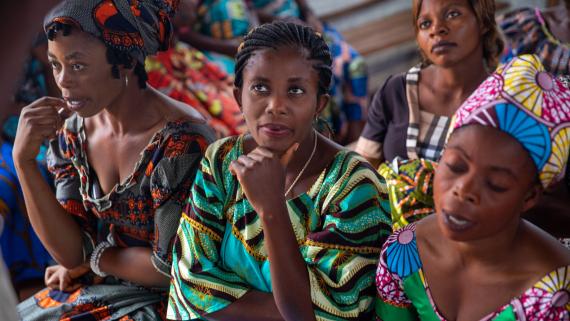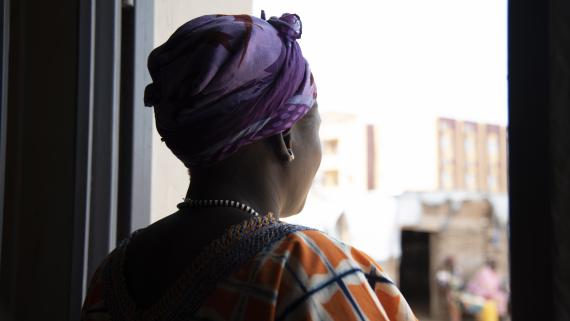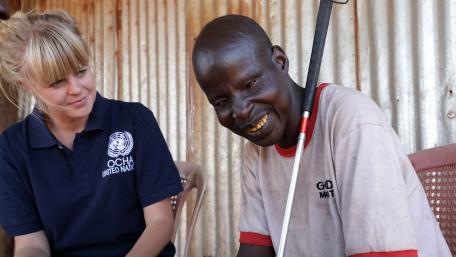Kalemie, DRC
Women were sexually assaulted outside the Elinya IDP camp when they went to fetch water more than 5 km away. Suffering trauma, many women hid what happened to them out of fear of their husbands' reaction. The NGO Transcultural Psychosocial Organization offers support so that these women can resume their normal activities. OCHA/Alioune Ndiaye
Humanitarian contexts affect women more heavily: 70 per cent of women experience gender-based violence (GBV) in humanitarian contexts compared with 35 per cent worldwide. Humanitarian crises disrupt family and social networks, change the roles played by different genders and break down protection structures. Existing inequalities for women and girls risk being further exacerbated during and after a crisis.
Adolescent girls in conflict zones are 90 per cent more likely to be out of school than girls in non-conflict settings. Sixty per cent of preventable maternal mortality takes place in settings of conflict, displacement, and natural disasters. Every day, 507 women and adolescent girls die from pregnancy and childbirth complications in emergency settings.
COVID-19 has shed even greater light on the full extent of gender inequality, its impacts on women and girls and their exposure to violence. Across the globe domestic violence has been exacerbated by quarantine measures as victims and survivors are confined with their abusers. UNFPA predicts 15 million additional cases of gender-based violence for every three months of lockdown. The pandemic’s effects could also bring about an additional 13 million cases of child marriage - which can be avoided. While GBV and gender equality are not synonymous and should be treated as distinct streams of work, GBV is included together with gender equality to reinforce the need to address the gender inequality root causes of GBV and, in order to achieve gender equality, women and girls must be protected from GBV.
Gender-based violence: an overview

Gender-based violence (GBV) is an umbrella term for any harmful act perpetrated against a person’s will, and which is based on socially ascribed gender differences between females and males. The term encompasses acts that inflict physical, sexual or mental harm or suffering; threats of such acts; coercion; and other deprivations of liberty. These acts can occur in public or private. Domestic violence, rape, trafficking, early and forced marriage, sexual harassment, and sexual exploitation and abuse are some of the types of GBV common in humanitarian emergencies. GBV is deeply rooted in gender inequality and discriminatory gender roles and norms. During humanitarian emergencies, gender dynamics may be affected, and inequalities worsened, further fuelling risks of GBV for women and girls. This is especially when family and community protections have broken down, exposing women and girls to attacks as they perform gender roles, such as fetching water, food and firewood. They may also be targeted by armed actors who use sexual violence as a tactic of war, control and exploitation.
Addressing all forms of GBV is a priority in humanitarian settings because such acts pose immediate and life-threatening health consequences. Women and girls with disabilities are even more at risk. It is therefore important that humanitarian actors ensure that their actions and initiatives prevent and mitigate GBV from the onset of emergencies.
OCHA/Alioune NdiayeWomen make up the majority of those in the health and social work industry. They are frequently called on to care for family including the sick and elderly, putting them at increased risk of infection. Women face other knock-on effects of the pandemic: access to sexual and reproductive health are disrupted as are livelihoods, due to their lack of access to resources and/or their prevalence in the informal economy. The gendered implications of the COVID-19 health emergency have been prioritized by humanitarian actors from the onset of the COVID-19 response. Gender analysis and implications have been highlighted in the Global Humanitarian Response Plan to mitigate protection and social economic impacts of COVID on women and girls in humanitarian settings.
South Sudan: partnering with local actors to address GBV

The humanitarian crisis plus the COVID-19 pandemic have increased the vulnerability of women and children to GBV. Between January and September, 6,295 GBV incidents were recorded. Two country-wide toll-free helplines were established to support survivors seeking timely and confidential assistance. The much-needed helplines are run by two women-led local NGOs, in collaboration with national authorities. The helplines received nearly 1,000 calls mainly from urban settings. To facilitate access to a diverse group of the vulnerable population, response officers with various language skills and experiences act as operators providing remote support.
The helplines have enabled remote preliminary counselling, referrals and case management for survivors in distress or at risk of violence. Follow-up phone calls, home visits and financial support have also been extended to survivors. Out of people targeted to receive GBV prevention and response services in 2020, 31 per cent were reached. The majority of response services are concentrated in Unity, Central Equatoria, Jonglei and Upper Nile States.
UNICEF/Helene RyengFurther reading
Source: United Nations
Source: UN Women
Source: UNFPA
References
- ActionAid On the frontline: Catalyzing women’s leadership in humanitarian action (p. 10), 2016 and OCHA, World Humanitarian Data and Trends 2016 (p.3)
- UNESCO, Humanitarian aid for education: Why it matters and why more is needed, 2015
- OCHA, World Humanitarian Data and Trends 2016
- UNFPA, New UNFPA projections predict calamitous impact on women’s health as COVID-19 pandemic continues, 28 April 2020
- UN, Gender equality in the time of COVID-19, 2020





